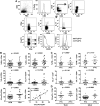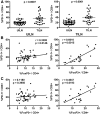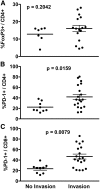Programmed death-1+ T cells and regulatory T cells are enriched in tumor-involved lymph nodes and associated with aggressive features in papillary thyroid cancer
- PMID: 22466343
- PMCID: PMC3387418
- DOI: 10.1210/jc.2011-3428
Programmed death-1+ T cells and regulatory T cells are enriched in tumor-involved lymph nodes and associated with aggressive features in papillary thyroid cancer
Abstract
Context: Recurrent metastatic lymph node (LN) disease is common in patients with papillary thyroid cancer (PTC). Novel prognostic markers may be helpful in guiding a therapeutic approach. Our previous studies revealed that immune suppression is evident in PTC and associated with more severe disease.
Objective: To characterize the immune response to metastatic PTC, we assessed CD4(+) T cell polarization in LN. In addition, we investigated the role of programmed death-1 (PD-1) and T cell exhaustion.
Design: Uninvolved (UILN) and tumor-involved lymph nodes (TILN) were sampled ex vivo by fine-needle biopsy. T cell subsets were identified by flow cytometry. In parallel, archived TILN specimens were characterized by immunofluorescence.
Setting: The study was conducted at the University of Colorado Hospital.
Patients: Data were collected on 94 LN from 19 patients with PTC undergoing neck dissection.
Main outcome: T cell subset frequencies were compared in UILN and TILN and assessed for correlation with recurrent disease and extranodal invasion.
Results: Regulatory CD4(+) T cells (Treg) were enriched in TILN compared with UILN and further elevated in TILN from patients with recurrent disease. PD-1(+) T cells were present at high frequency in TILN and markedly enriched in TILN that showed evidence of extranodal invasion. In TILN, Treg frequency correlated with PD-1(+) T cell frequencies. Although PD-1(+) T cells produced interferon-γ, they failed to fully down-regulate CD27 and were not actively proliferating.
Conclusions: Increased Treg and PD-1(+) T cell frequencies in LN may be indicative of aggressive recurrent PTC. Future prospective studies are necessary to determine the prognostic and therapeutic value of these findings in PTC.
Figures





References
-
- Davies L, Welch HG. 2006. Increasing incidence of thyroid cancer in the United States, 1973–2002. JAMA 295:2164–2167 - PubMed
-
- Mazzaferri EL, Jhiang SM. 1994. Long-term impact of initial surgical and medical therapy on papillary and follicular thyroid cancer. Am J Med 97:418–428 - PubMed
-
- National Cancer Institute 2007. Surveillance Epidemiology and End Results (SEER): cancer statistics review, 1973–2005. National Institutes of Health: www.cancer.gov
-
- Bates GJ, Fox SB, Han C, Leek RD, Garcia JF, Harris AL, Banham AH. 2006. Quantification of regulatory T cells enables the identification of high-risk breast cancer patients and those at risk of late relapse. J Clin Oncol 24:5373–5380 - PubMed
Publication types
MeSH terms
Substances
Grants and funding
LinkOut - more resources
Full Text Sources
Medical
Research Materials

